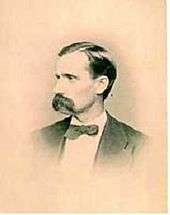Charles Frederick Hartt

Charles Frederick Hartt (23 August 1840 in Fredericton, New Brunswick – 18 March 1878) was a Canadian-American geologist, paleontologist and naturalist who specialized in the geology of Brazil.
Nova Scotia and New Brunswick
Hartt graduated from Acadia College in Wolfville, Nova Scotia, in 1860, and by his graduation he had made extensive geological explorations in Nova Scotia. In 1860, he accompanied his father, Jarvis William Hartt, to St. John, New Brunswick, where they established a high school for young women in which Charles Frederick taught for a year. Hartt also studied the geology of New Brunswick, and devoted special attention to the Devonian shales, in which he discovered an abundance of land plants and insects.[1][2]
Exploration in Brazil
In 1861, Hartt started to work as a student assistant for Louis Agassiz at the Museum of Comparative Zoology, Harvard University. This work lasted until 1864, when he received an appointment on the geological survey of New Brunswick.[1][2] In 1865 he accompanied Agassiz to Brazil in the Thayer Expedition. A creationist, Agassiz believed he could find geological proof of his theory concerning glacial action in Brazil that would knock down the evolutionist theory of Charles Darwin.[3]
Hartt fell in love with Brazil, and spent 15 months exploring the coastal regions from Bahia to Rio de Janeiro. The large zoological collections he made were later used to prepare his Geology and Physical Geography of Brazil (Boston, 1870).[1] In 1868 he was elected professor of natural history at Vassar College, but later in the same year he accepted a post at Cornell University, in Ithaca, New York, and planned to return to Brazil. Charles married Lucy Cornelia Lynde of Buffalo, New York, in 1869. They had two children, Mary and Rollin. Both children became writers.
In all, Hartt participated in four expeditions to Brazil (the Morgan Expeditions) from 1870 to 1878. He collected a great deal of data about the land and the people, contributing to new knowledge about the flora, the fauna, minerals, geography, linguistics and ethnography. He was an accomplished draftsman and illustrator and musician. In his last voyage he collected more than 500,000 specimens, which were donated to the National Museum of Rio de Janeiro, where he worked as the founder and director of the section of geology from 1866 to 1867.
In 1875, following a suggestion by Hartt, the Emperor Dom Pedro II (1825–1891) established the Imperial Geological Commission. The Commission was closed down after two years of work after losing the Emperor's support. Hartt was joined by his wife and children in Brazil in 1875, but they returned to the United States without him when his wife got pregnant.[4]
He died in Rio de Janeiro, after contracting yellow fever, at the age of 38.
One of his students, the American geologist Orville Adalbert Derby (1851–1915), succeeded him at the National Museum, after having accompanied him in two of the Morgan Expeditions (1870 and 1871) and having worked with him at the Imperial Commission.
Publications
- Thayer Expedition (1870)
- Geology and physical geography of Brazil (1870)
- Amazonian Tortoise Myths (1875)
- Notes on the Manufacture of Pottery Among Savage Races (1873)
Bibliography
- Sanjad, N. Charles Frederick Hartt and the institutionalization of the natural sciences in Brazil. Hist. cienc. saude-Manguinhos, vol.11 no.2, Rio de Janeiro May/Aug. 2004.
- Lopes, M. M. C. F. 1994 Hartt's contribution to Brazilian museums of natural history'. Earth Sciences History, 13(2), pp. 174–9.
- Freitas, M.V. Hartt: Expedições pelo Brasil Imperial Metalivros, 2002.
References
- 1 2 3
 One or more of the preceding sentences incorporates text from a publication now in the public domain: Wilson, James Grant; Fiske, John, eds. (1892). "Hartt, Charles Frederick". Appletons' Cyclopædia of American Biography. New York: D. Appleton.
One or more of the preceding sentences incorporates text from a publication now in the public domain: Wilson, James Grant; Fiske, John, eds. (1892). "Hartt, Charles Frederick". Appletons' Cyclopædia of American Biography. New York: D. Appleton. - 1 2 Squires, W. Austin (2000). "Hartt, Charles Frederick". Dictionary of Canadian Biography Online.
- ↑ http://www.revistapesquisa.fapesp.br/?art=1694&bd=1&pg=1&lg=en
- ↑ http://www.myhartt.com/families/charles_frederick_and_lucy_hartt.htm
External links
| Wikisource has original works written by or about: Charles Frederick Hartt |
- The Museu Nacional and its European employees. Jens Andermann
- The Man Who Abandoned Himself to Nature. Boletim Informativo UFMG (In Portuguese)
- Contributions of Charles Frederick Hartt for Brazilian ethnography (Biblioteca Digital Curt Nimuendaju)
- Works by or about Charles Frederick Hartt at Internet Archive